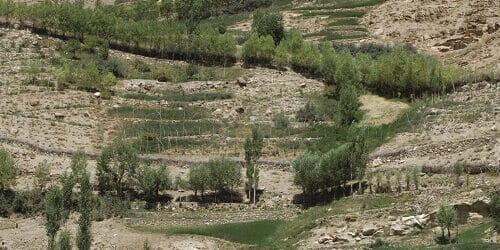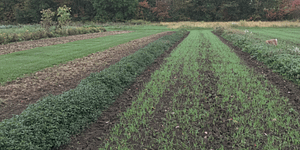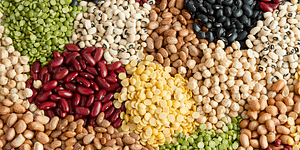To Create Climate-Secure Foodscapes, Think Like a Plant

The techniques and prophetic vision for achieving food security and foodscapes in the face of climate change contained in Gary Paul Nabhan‘s Growing Food in a Hotter, Drier Land may well need to be implemented across most of North America over the next half-century, and are already applicable in most of the semiarid West, Great Plains, and the U.S. Southwest and adjacent regions of Mexico.
In this excerpt, Nabhan explains how a better understanding of biomimicry – and thinking like a plant – could help humans better adapt agriculture to accelerated climate change.
The challenges facing any form of food production in a time of rapid climate change can seem daunting. Indeed, they would be absolutely impossible to deal with if there were not already time-tried strategies to draw upon as means to adapt to a hotter, drier, more uncertain world.
In this way, we are fortunate: We are not beginning at the 11th hour with a disarmingly blank slate. There are many ways to adapt to drought, heat, and wilder, less predictable ecological oscillations; we can successfully adapt because they have, in fact, already been “field-tested” by nature’s diverse organisms and ecosystems and by myriad human cultures. Many species—including humans—have subsisted on the 10 to 17 million square miles of arid and semi-arid landscapes on this planet over the last 10,000 years. During most of those millennia, our climate has been relatively stable for food production relative to what we may be facing over the next century; nevertheless, it has been theorized that what triggered the very origin of agriculture on several continents 8,000 to 10,000 years ago was warming and drying trends, which forced the growing human population to innovate in order to achieve greater food security. As we now enter the new normal of even greater climatic uncertainty, we may have to scale up the most promising adaptations that desert dwellers have improvised over the last several centuries to achieve greater resilience in our food systems as a whole.
In short, emulating and refining these adaptations to serve as a foundation for our own may help us secure food in the face of climate change. At the least, they will give us much “food for thought” as we wander into a world that is quite different from the one we have lived in most of our lives.
To access, understand, and fit these modifications to our own place, we will inevitably need to tune in to a couple of vast networks of valuable information: We must remember or relearn how nature works to reduce stress in plants, animals, or arid ecosystems. Then we must study traditional ecological knowledge, designs, behaviors, and practices of indigenous and immigrant cultures that have long foraged, herded, hunted, or farmed in desert landscapes. And so, if we are to specifically use the wisdom found in deserts and their ancient cultures to design healthy, resilient food-producing communities with small carbon foodprints, we might rephrase our operating instructions in this manner:
- Desert dwellers make use of abundant sunlight as their primary means to fuel food production, but they also know how to deflect its heat to reduce moisture loss.
- Desert dwellers only use the water and energy they immediately need, and try to store any excess underground for periods of scarcity.
- Desert dwellers are ergonomically shaped and prone to behave in ways that reduce drought and heat stress, but often do so most effectively when clustered or “stacked” into the multiple vertical strata known as nurse plant guilds such as those in oasis habitats.
- Desert dwellers rapidly and efficiently recycle resources whenever both water and energy become available to do so.
- Most desert dwellers may be biologically programmed to compete with one another for scarce resources, but cooperation, synergy, and symbiosis have nevertheless become the norm more than the exception within and among desert communities.
- While desert communities may appear sparsely populated and less diverse than tropical or temperate rain forests to the unacquainted eye, they offer impressive levels of diversity among soil microbes, plants, pollinators, and frugivores, but on temporal and spatial scales very different from those of forests.
- The crop species that work well in stable, temperate climates may fail under more arid conditions. Deserts have evolved not only unique arid-adapted species, but unique webs of relationships to efficiently capture sunlight, water, and fertility to produce food. They can survive and even thrive in settings where “generalists” suited to stable, more moderate conditions can’t make it.
- Deserts have little tolerance for excess; they are stripped-down, elegant ecosystems that can rapidly shed any excess baggage during periods of stress. Desert shrubs often drop their leaves and reduce their root mass during extended droughts, only to rapidly regrow them following sudden bursts of rainfall.
- Desert dwellers humbly accept the inherent constraints of the desert. As I’ve noted, a Pulitzer Prize–winning western writer once quipped that newcomers to the desert must learn to “get over the color green.” Because many of us recognize that water scarcity is a norm, not an aberration, the water-saving strategies of desert plants can inspire us to innovatively make the wisest use of the resources that are available.
I do not assume that all readers and users of this book will be residents of arid or semi-arid regions of this planet. But I sense that every farmer, rancher, or orchard-keeper at this point in time can gain something by considering and implementing some of the desert’s basic “operating instructions.” It is in this way that I am encouraging you—as food producers, consumers, and visionaries—to use the metaphor of desert survival as a means to go beyond biomimicry as an exploratory tool that works merely for the design of individual products or processes.
In effect, it is not enough to simply put a drought-adapting or heat-stress-reducing structure in place, for you will need to learn how to integrate its management into your daily behavior if it is to be effective over the long haul. For instance, my straw bale house has electric shutters over the windows to reduce heat loads over the summer and retain heat during winter nights, but until I learned to immediately activate them as soon as stressful weather conditions began to set in, I hardly garnered any of their benefits. In short, each of us needs to embrace the deeper ways to adapt to and survive climate change, rather than thinking it is about purchasing or constructing quick-fix gimmicks.
I am asking you to get under the skin of certain desert plants, communities, and cultural manifestations and to “think” (intuit, behave, perform) as they do. Just as Aldo Leopold asked wildlife conservationists to engage in “thinking like a mountain,” my challenge to food producers is to engage in thinking like a century plant, a tepary bean, a semi-arid prairie, or a desert oasis. Let’s see what this might look like.
Biomimicry: Becoming Co-Designers of a Climate-Resilient Foodscapes
When the term biomimicry was first coined in the 1980s, and even when it was popularized by Janine Benyus in the late 1990s, few permaculture activists fully understood that climate change was already having a perceptible effect on food production. Nevertheless, many of the design principles elucidated by Benyus and her colleagues at the Biomimicry Institute could play an enormous role in helping humankind adapt and diversify agriculture to weather the next century of accelerated climate change. Below in bold are the principles (as expressed by Benyus), with my efforts to link them to climate-friendly food systems in italics:
- Nature runs on sunlight. To be sustainable, your food system must be redesigned to have a lower carbon foodprint, being run largely on solar energy rather than on fossil fuels.
- Nature uses only the energy it needs. You will target the energy flowing into your freshly designed food system to produce and distribute food with the highest ratio of nutritionally dense calories brought to the table to number of calories expended getting it there (while maintaining a resilient infrastructure to do so).
- Nature fits form to function. The crop varieties you select will be adapted to the environment, rather than requiring you to use excessive water and fossil fuel to remake the environment to fit the crop’s needs.
- Nature recycles everything. No organic materials will be left behind; you will reduce your ecological foodprint by trying to repurpose almost everything!
- Nature rewards cooperation. You’ll never farm alone; watersheds, soil microbes, pollinators, and other neighbors will be there as allies farming with you!
- Nature banks on diversity. If your foodscape is designed to be rich in agricultural traditions, species, varieties, microbes, and strata, it will offer much of the resilience you need in the face of climatic disruptions.
- Nature demands local expertise. While seeking inspiration for redesigning your food system, draw upon the wisdom of local (or bioregional) cultures, species, habitats, and plant associations or guilds. Let your homeland be your mentor, your genius loci.
Biomimicry 1: Thinking Like a Century Plant
Century plant is the common English name for a succulent species in the genus Agave. They are desert plants, known in the Spanish-speaking world as mescal, maguey, or wild relatives of the blue agave of tequila fame.
Many century plants are rainwater harvesters in the sense that their rosettes of sword-shaped leaves foster the trickle of both rain and fog-like mist back to their roots. (By piling pebbles and small stones around the base of cultivated century plants, prehistoric farmers in Arizona actually created “fog and dew collectors” that not only increased yields but also fostered the propagation of more agaves.) Like other succulents during the hottest, driest months, they can slough off much of the mass of their root hairs and thus reduce their living biomass requiring support. And in turn, they can quickly grow them back once the rainy season arrives. Both their narrow, thick leaf morphology and grayish green color allow them to reduce heat loads during hotter, drier seasons. In short, they have a low surface-to-volume ratio by virtue of their aboveground architecture, yielding minimum water loss. (Once, on a desert island in the Gulf of California, I assisted a Seri Indian elder in the harvest and pit-roasting of century plants during a dry year, and when annual rainfall had been less than 4 inches for several years: The plants had survived and thrived largely through the moisture left on their leaves by occasional coastal fogs!)
Century plants have adapted to water scarcity and heat by fixing most of the carbon they gain through photosynthesis during the night rather than during daytime hours, when both heat stress and water loss from leaves would put them more at risk. Through a metabolic pathway nicknamed CAM (crassulacean acid metabolism), they can keep their leaf pores (stomata) closed during the day to reduce water loss, while still photosynthesizing. Then they open their pores during the night, when it is cooler and water loss through transpiration from their leaves is less, and they produce a four-carbon compound, which they can store deep in their tissue. Only as seedlings or after extended periods of high rainfall do they open the stomatal pores during the daytime.
If equal parts water were applied to an annual crop (such as corn, sorghum, soy, or wheat) and a field of giant century plants used for making fermented pulque beverages, the latter would easily surpass the cereals and legumes in productivity per acre. In fact, they can generate twice the dry biomass per area as hybrid poplars grown for pulp, and they produce three times as much sugar as sugarcane yields in the same area of planting. When water is available in the desert, they use it 10 times more efficiently than cereal crops. Already adapted to the arid and semi-arid conditions currently found on one-fifth of the planet’s land surface, they can easily withstand drought, heat spells, and rising carbon dioxide levels in the atmosphere. Within the 200 million acres of their native range in Mexico, agaves can annually produce as much as 5,600 million tons of edible or drinkable biomass on far less water than almost any other crop, with the possible exception of prickly pear cactus.
Biomimicry 2: Thinking Like an Ephemeral Tepary Bean
Tepary beans—desert relatives of pintos, limas, and runner beans—are among the most drought-adapted annual legumes on earth. Just 30 days after germinating, tepary plants begin to flower; they can produce a harvestable crop of dry beans in just 55 to 65 days under desert conditions. As such, these plants use the drought-avoidance strategies of many desert wildflowers by growing only during the brief summer monsoon season when soil moisture is available in North American deserts, and then producing a yield and dying before drought returns. As we will discuss in chapter 7, they are sometimes classified as a drought-evading “ephemeral” rather than an annual crop plant, since their entire life cycle is so much shorter than the frost-free growing season.
What design elements allow tepary beans to withstand hot spells of 100 to 125˚F (38–52˚C) and to germinate, survive, and produce seed on as little as two hard rainfalls per season?
First, they put much of their energy into rapidly growing deep, water-absorbing roots rather than producing a lot of “excess” foliage. Their roots can reach depths of 8 feet in less than three months’ time, and extend much farther belowground than the vines do aboveground. Next, their leaflets are much narrower and their flowers are smaller than those of other beans, so they have a smaller surface area exposed to the sun than do most bean plants. They also exhibit “self-shading,” whereby their flowers and newer, tender foliage are often in the shadow of older, tougher leaflets. Internally, their proteins have higher heat tolerance, so they can bloom and set seed during hot spells that damage the leaves of pinto or lima beans and force their developing embryos to abort.16 At midday, when air temperatures are above 100˚F (38˚C) and solar radiation can be brutal for other beans, tepary leaflets simply angle their surfaces away from the sun, but most of the rest of day their leaves behave like solar trackers—that is, they shift their angles to maximize photosynthetic gain as much as possible (see chapter 4).
Curiously, tepary plants require a mild drought or hot spell to trigger flowering and fruiting. When they have been grown in the past in wetter, cooler areas such as Minnesota, they seldom receive such a trigger, so they continue to produce as much green foliage as an alfalfa plant might in an irrigated pasture. When they are prompted to flower and fruit, they behave much like mature century plants, converting most of their vegetative biomass to seeds and pods, literally killing themselves while trying to reproduce. Tepary beans have been grown by more than 30 native and immigrant cultures residing in the North American deserts of Mexico and the United States, which value them for their low water use, flavor, and nutritional value.
Eco-Mimicry: Thinking Like a Semi-Arid Prairie
Eco-mimicry is somewhat of a different dance from biomimicry or ethno-mimicry, for it requires protracted attention toward the way in which members of a plant and animal community work together to produce a variety of foods in a self-sustaining manner. Eco-mimicry allows us to imitate ecological relationships, habitats, and ecosystems—not merely the adaptations of a single species.
During a blazing-hot summer in 1979, I took a bus ride across the West to spend a few days at the Land Institute with Wes Jackson and his soon-to-be Sunshine Farm manager, Marty Bender. Despite being in the midst of a heat wave that scorched soybean, corn, and wheat fields nearby, the prairie outside of Salina, Kansas, remained resplendent with wildflowers and resilient in the face of so much heat stress. Over the course of the following decades, I’ve frequently returned to the Land to speak, and have remained friends with Wes and his daughter Laura ever since.
Our friendship blossomed over conversations about the domestication of herbaceous perennial crops.26 At the time, I was working as part of an Arizona team attempting to domesticate buffalo gourds, a wild relative of squashes, while they worked on domesticating eastern gamagrass, a wild relative of maize. But over the years, our conversations deepened. We debated how we could design resilient agricultural ecosystems on the models of prairies, cactus forests, and temperate rain forests. Nature as measure and model became our shared rallying cry.
Many students have grown so excited by the Land Institute’s initial successes in domesticating wild perennial grains, legumes, and sunflowers that they literally can’t see the prairie for its grasses. To me, Wes Jackson offers more than his finely honed expertise on perennial plant breeding (certainly a genius loci that deserves celebration); he is also an agro-ecologist who has contributed much to conversations steeped in reinventing food production systems in the face of climate change.
Whether the plants in his agro-ecosystem designs are fully domesticated or semi-cultivated, none will be grown in monoculture in the Land Institute’s designs, nor will they include genetically narrowed annuals that require the incessant tillage, fertilization, and pampering that most industrial farming has demanded over the course of the last half century. Ideally, 12 to 15 different harvestable food species from several different plant families will be grown together in a single field to provide the highest yield stability in perennial polycultures suited to the conditions of the prairie biome—the landscape that stretches most of the way across the honey-colored heartland of America.
Ethno-Mimicry: Thinking Like a Desert Oasis
Modern permaculturists were not the first, nor will they be the last, to think of planting sets of temperature-sensitive plants as “guilds” in the shady canopies of fruit, pod, and nut trees. Traditional desert farmers have been doing this for centuries, from the Gobi in China to the Sahara in Africa all the way to the Sonoran in Baja California. Perhaps they initially mimicked the vertical structure of small trees, shrubs, and herbs that grew beneath palms and olive trees, finding species with edible fruits, nuts, or leaves to propagate beneath date palms.
Whatever the cultural origin of desert oasis agriculture, there is now an archipelago of island-like oases from Persia through Morocco that has harbored true food forests continuously for upward of 1,400 years. This is all the more impressive if you consider how easily salinity and alkalinity can accumulate and degrade soil quality around the artesian springs that water most desert oases. It may be that the vertical stacking of one kind of leafy canopy over another, and one kind of root system under another, reduces or processes the accumulation of minerals so that the associated food plants can remain productive.
Recent Articles
Want to make the most of the slow gardening season? Lay cover crops to improve the health of your soil and plants! The following is an excerpt from The Celestial Garden by Jane Hawley Stevens. It has been adapted for the web. Benefits of Cover Crops Cover cropping is a management practice that benefits the…
Read MoreInterested in micro-farming, but don’t know where to begin? Believe it or not, you only need 9 tools to get started. These easy-to-find tools for micro-farming will set the stage for productive growing! The following is an excerpt from The Lean Micro Farm by Ben Hartman. It has been adapted for the web. Unless otherwise noted, all…
Read MoreSeeds are the foundation of agriculture. As John Navazio describes in this excerpt, America was once home to hundreds of small-scale agricultural seed producers, each of which developed seeds adapted to grow best in the surrounding region. Today, following the trend of most businesses, just a few large companies provide seed for farmers everywhere. With…
Read MoreLooking for a veggie to grow and harvest through winter? Try leeks! With some careful planning, a bit of elbow grease, and some insight from Eliot Coleman, you’ll enjoy leeks from your garden all year long. The following is an excerpt fromThe Winter Harvest Handbook by Eliot Coleman. It has been adapted for the…
Read MoreDid you ever wonder how leeks, kale, asparagus, beans, squash, and corn have ended up on our plates? Well, so did Adam Alexander, otherwise known as The Seed Detective. The following is an excerpt from the The Seed Detective by Adam Alexander. It has been adapted for the web. My Seed-Detective Mission Crammed into two…
Read More









